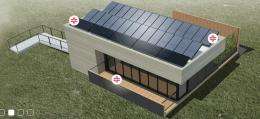September 22, 2009 weblog
Solar Home Built by Students

(PhysOrg.com) -- Students from the Boston Architectural College (BAC) and Tufts University have submitted a completely solar-powered home, the Curio House, as New England's entry into the Solar Decathlon competition. The entry is one of 20 designs by teams of university students vying for this year's award for the best solar home design.
The solar home will be dismantled and reassembled on the National Mall in Washington, D.C., early next month, where it will be subjected to 10 days of judging. The student-designed home will be open to the public, and will be judged on factors such as attractiveness of the design, marketing viability, energy efficiency, and the amount of excess electricity the home generates.
The budget for the New England team's design for the 800 square foot one-story home came in at around $200,000, and they hope the sale price could be about the same figure, but for a reduced number of solar panels. The sale price would make the design far more marketable than the 2007 competition design by a German team, which would sell for $1.2 million.
The Boston students worked for nearly two years on the project. They reduced costs by purchasing widely available products from building supply stores, and by using a simple, modular design that could be constructed easily. The most expensive items were the bank of 28 top range SunPower photovoltaic panels and five solar thermal panels to heat the home and supply hot water.
Tufts student Matt Thoms, who served as project director for the Curio House engineering and photovoltaics, said the team wanted to build a house that could be available now, and not something that would not be available on the market for five to ten years.
The students also wanted to design a house that would be suitable for city and urban living, and not just for people in rural areas living off the grid. With this in mind, the house is designed for a couple with a small child, and it includes screens for the front deck and back porch that would provide privacy. The house has technologies expected in today's city homes, such as Ethernet, but it also has a small garden watered by captured storm water to encourage the occupants to grow some of their own food and live a more sustainable lifestyle.
The photovoltaic panels supply 6.4 kW, which is more than a home of the same size would need if connected to the grid, but for the competition the home must run for 10 days off the grid. A number of jobs must be completed, such as a movie night featuring the home's entertainment system, and washing 10 loads of laundry during the period. Batteries fed by the solar panels produce night time and cloudy day electricity supplies for the home.
The Curio House is well insulated to reduce heating and cooling needs, and is fitted with energy-efficient appliances and lights. It also has outdoor blinds on the southern side that can be adjusted to allow sunlight in for warmth and light. As a result of these features the students expect the electricity use to be around one third that of a typical American home of the same size.
The students focused on designing a home that is affordable enough for people to live in now, and they have already found a buyer, since the building will become the first home in a "green community" planned for Cape Cod. The design can also be adapted for larger homes or apartments.
The Solar Decathlon is held every two years and is run by the U.S. Department of Energy.
More information: www.livecurio.us/
© 2009 PhysOrg.com


















